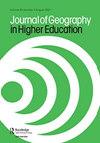大学生地下水空间思维调查
IF 1
4区 教育学
Q2 EDUCATION & EDUCATIONAL RESEARCH
引用次数: 4
摘要
本科生对水系统,尤其是地下水的了解可能不够充分。在本科课堂中运用模型和建模来支持学生对水的学习。然而,有效的建模需要空间思维能力,这也是本科生可能需要培养的。在这里,本科生在一门介绍性的水课程中使用了一个基于计算机的地下水模型,我们在课程的两个连续迭代中探索了学生对地下水的空间思维。我们报告了在课程中进行的一项描述性研究的结果,通过对学生任务和访谈进行定量和定性分析,我们探索了学生对空间、表征和推理的理解。研究结果表明,学生可能会在空间思维的某些组成部分上遇到困难,比如表达和推理的工具。具体来说,学生们在解释模型表示(如等高线)方面有困难,并且很难推断地下水的流动。然而,学生在空间思维的其他方面表现更好,比如空间概念。总的来说,这些结果表明学生们在与地下水模型相关的空间思维的某些方面遇到了困难。这些发现对地下水的本科教学和学习具有启示意义。本文章由计算机程序翻译,如有差异,请以英文原文为准。
An investigation of undergraduate students’ spatial thinking about groundwater
ABSTRACT Undergraduate students may possess underdeveloped knowledge about water systems, particularly groundwater. The use of models and modeling have been employed in undergraduate classrooms to support students’ learning about water. However, effective modeling requires spatial thinking skills, which undergraduate students may also need to develop. Here, undergraduate students used a computer-based groundwater model in an introductory water course and we explored students’ spatial thinking about groundwater in two consecutive iterations of the course. We report findings from a descriptive study conducted in the course, through which we explored students’ understanding of space, representation, and reasoning by conducting quantitative and qualitative analyses on student tasks and interviews. Findings suggest that students may struggle with certain components of spatial thinking, such as tools of representation and reasoning. Specifically, students had difficulties interpreting model representations such as contour lines, and struggled to reason about groundwater flow. However, students performed better on other aspects of spatial thinking, such as concepts of space. Overall, these results suggest students struggle with certain aspects of spatial thinking in relation to this groundwater model. These findings have implications for undergraduate teaching and learning about groundwater.
求助全文
通过发布文献求助,成功后即可免费获取论文全文。
去求助
来源期刊

Journal of Geography in Higher Education
Multiple-
CiteScore
5.80
自引率
9.50%
发文量
29
期刊介绍:
The Journal of Geography in Higher Education ( JGHE) was founded upon the conviction that the development of learning and teaching was vitally important to higher education. It is committed to promote, enhance and share geography learning and teaching in all institutions of higher education throughout the world, and provides a forum for geographers and others, regardless of their specialisms, to discuss common educational interests, to present the results of educational research, and to advocate new ideas.
 求助内容:
求助内容: 应助结果提醒方式:
应助结果提醒方式:


